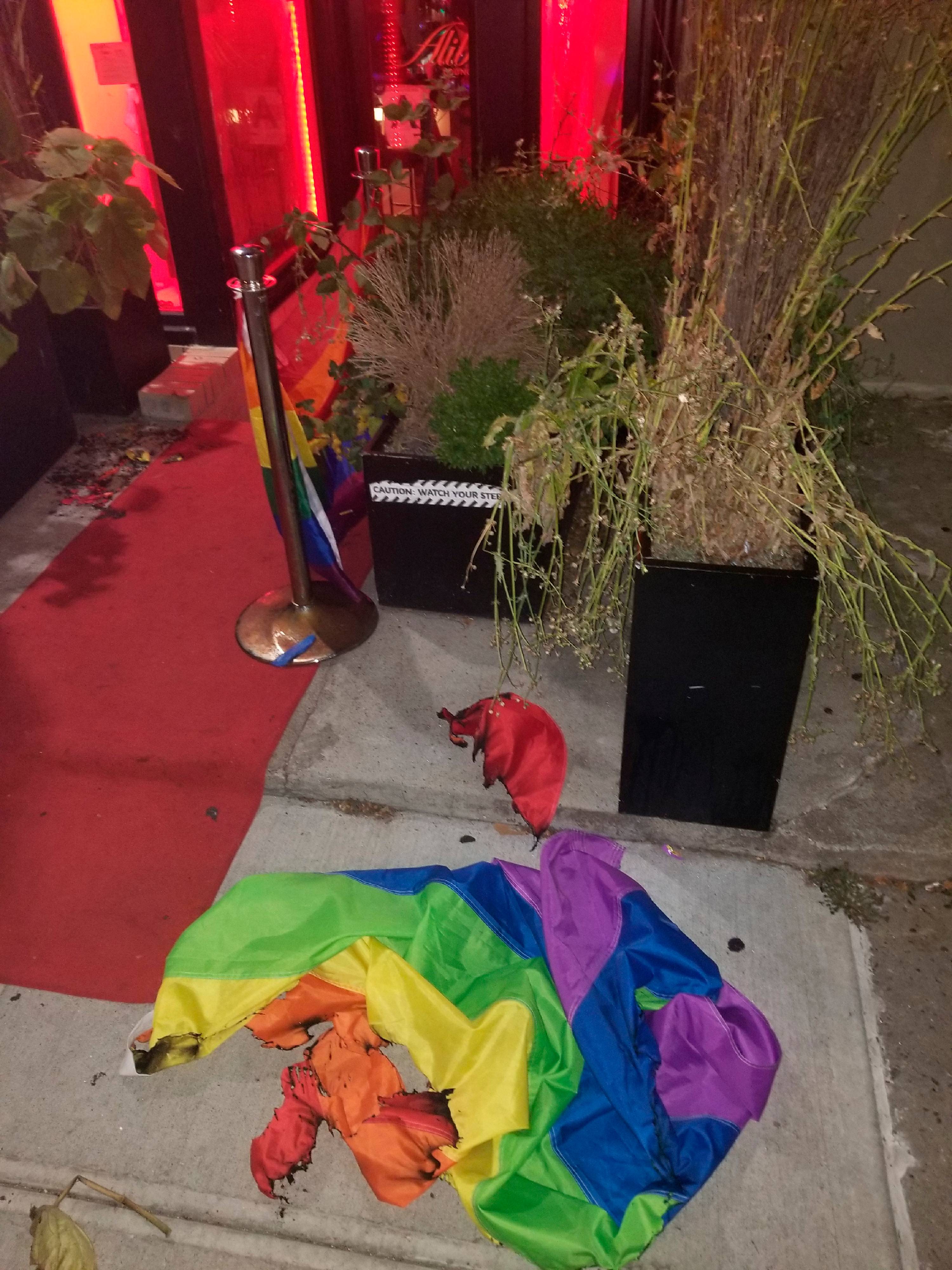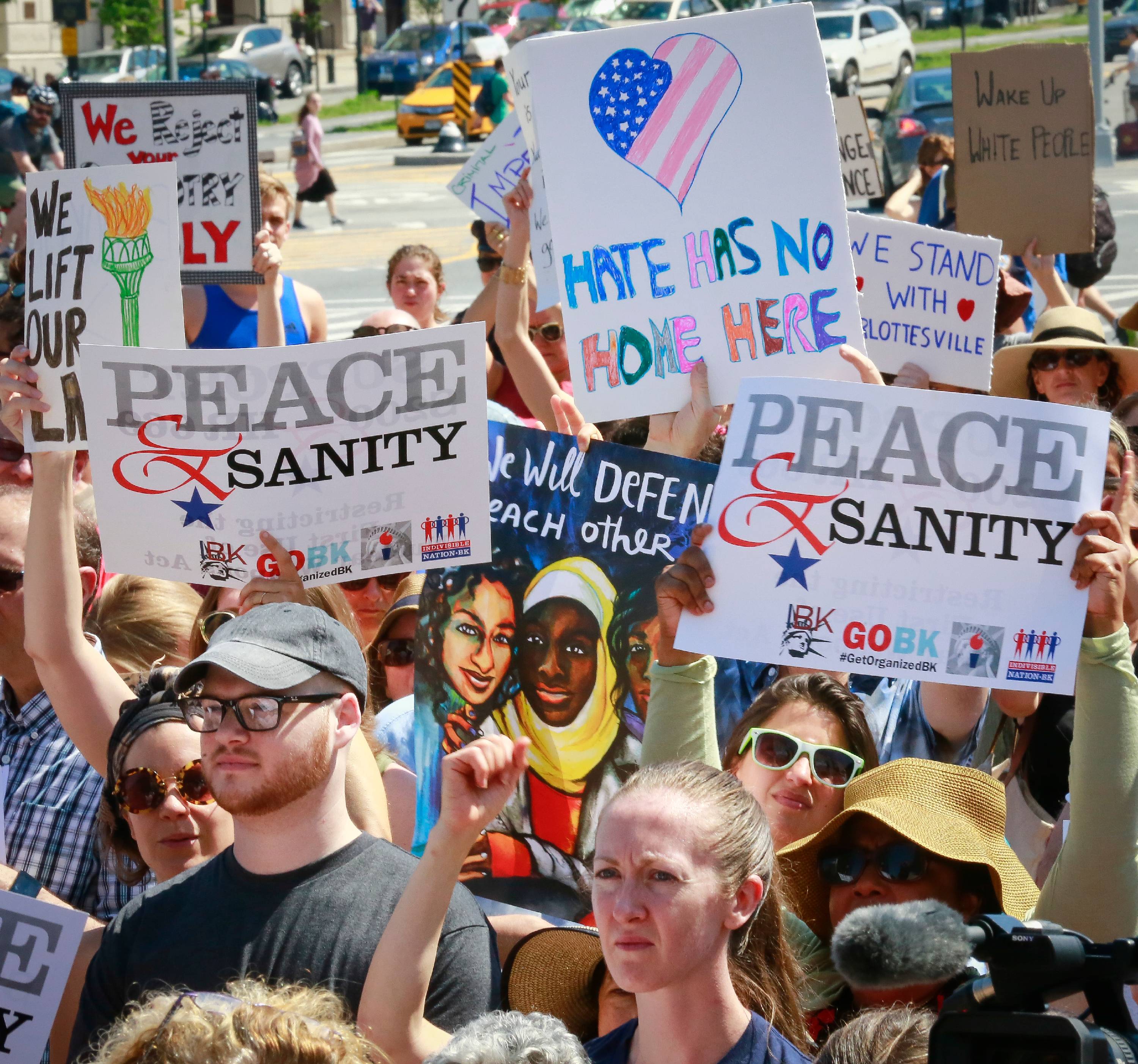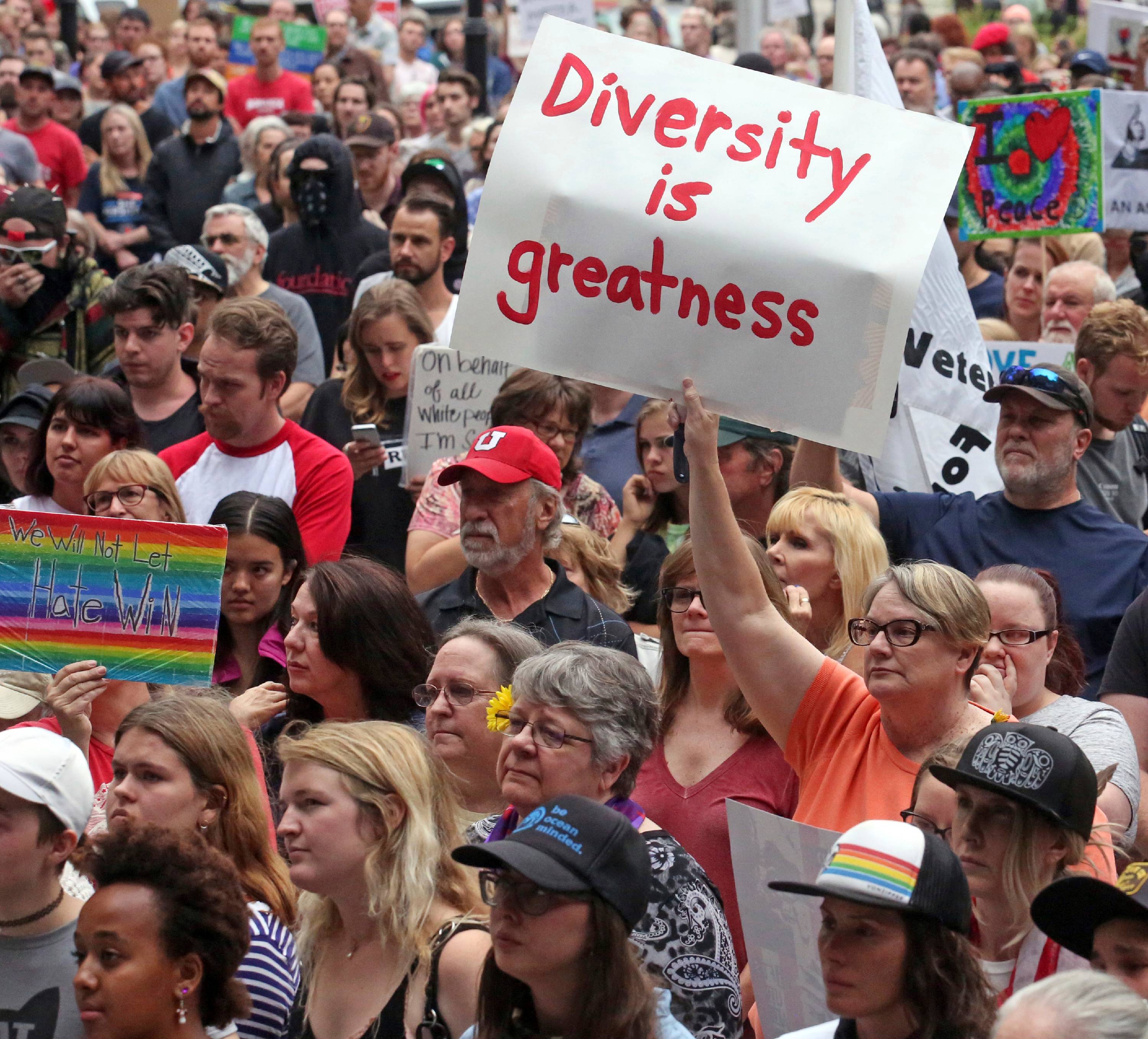A Disturbing Trend
Swastikas painted on buildings, a Mexican woman beaten and left for dead and verbal threats shouted by drivers on the road.
These are just some of the approximately 2,300 recently documented acts of hate hurled toward specific groups in the tri-state area.
Video: Hate on the Rise in New Jersey
News 12 New Jersey has compiled, researched and organized hate-crime data that shows disturbing incidents of hate at a time when the country seems more divided than ever. The incidents have left a deep impact on individuals and communities in New York, New Jersey and Connecticut.

Statistics researched for this project show the Jewish community to be among the most common target of hate. However, the incidents overall impact a wide range of victims from a variety of backgrounds.

A burned rainbow flag lays on the stoop of the Alibi Lounge, early Monday, July 8, 2019, in New York City. (Alexi Minko via AP)
Hate on the Rise
Hate is on the rise in New Jersey, but a Kane In Your Corner investigation finds only 1 percent of bias incidents result in bias convictions.
There were 569 confirmed bias incidents last year, according to records from New Jersey State Police, a 55 percent rise since 2015. Hate affected all corners of New Jersey, from East Brunswick, which had 40 bias incidents last year, to Evesham Township, which had 22, to Lakewood, which had 20. There were even 32 bias incidents on the New Brunswick campus of Rutgers University alone.
Podcast: Hate at Home
Kane In Your Corner
built a database of every bias incident in New Jersey since 2016. The incidents included everything from victims assaulted with guns, box cutters and baseball bats, to hundreds of reports of swastikas and hateful graffiti.
Interview: Keith Brown recounts being attacked on an NJ Transit train
Keith Brown was attacked on an NJ Transit train by a man who made anti-Muslim remarks. “He said ‘N--- Muslim, you are an N--- Muslim’,” Brown recalls. “And then ‘you with that thing on your head why don’t you go back to your own country’?”
The “thing” on Brown’s head was a cap known as a Kufi, commonly worn by Muslim men. And as Brown is quick to point out, his country is this country. “I was born in Florida,” he says, “played football, love hotdogs and apple pie.”
I can’t sleep, I’m nervous, I don’t feel safe.
Brown’s attacker pleaded guilty to simple assault, in return for having bias intimidation charges against him dropped. The outcome leaves Brown’s sister, Zanetta, frustrated. “There’s nothing simple about that assault, she says. We need to call it what it is. It was done out of hate.”
Heat Map: Hate incidents by frequency:
Beronica Ruiz was beaten on a Passaic street corner in June. She suffered a concussion, fractured orbital bone and fractured nasal cavity. Her alleged attacker was just 13, part of a group she says taunted her son at school, telling them Mexicans “needed to be behind a wall.” Since the attack, Ruiz says “I can’t sleep, I’m nervous, I don’t feel safe.”
Interview: Beronica Ruiz on her attack and its lasting impacts
Prosecutors declined to charge Ruiz’s assailant with bias intimidation, in part because of his age.

Tom Garing cleans up racist graffiti painted on the side of a mosque in what officials called an apparent hate crime, in Roseville, Calif. (AP Photo/Rich Pedroncelli)
In fact, Kane In Your Corner finds that since 2016, just 1 percent of confirmed bias incidents resulted in bias crime convictions. In 2017, there were 549 confirmed incidents, but only 34 arrests and only three convictions for bias intimidation, which is how New Jersey classifies hate crimes.
To your way of life, be yours, and to me be mine. But have a common ground of respect for one another so we can move forward.
New Jersey Attorney General Gurbir Grewal says there are “a lot of challenges” in prosecuting bias incidents and “the biggest challenge is: how do you prove the intent the individual had?” Other candidates, such as verbal abuse, typically don’t rise to the level of a crime at all. As a result, Grewal says, “there will be bias incidents that fall short of qualifying as bias intimidation crimes as we define them in our criminal code.”
Podcast: Interview with Attorney General Gurbir Grewal
Keith Brown says he accepts the outcome of his case, and worries more about the climate that made it possible. He hopes by telling his story publicly, he can help make a difference.
“To your religion, be yours, and to me, be mine,” he says. “To your way of life, be yours, and to me be mine. But have a common ground of respect for one another so we can move forward.”

Protesters listen during a "Peace and Sanity" rally in Brooklyn. (AP Photo/Bebeto Matthews)
Widespread Incidents
A terrifying moment aboard a Jitney bus in Passaic county, as a man with a box-cutter menaces a fellow passenger he believes is Muslim. In Lakewood, a synagogue is repeatedly spray-painted with anti-Semitic messages. And in Jersey City, vandals destroy religious icons three times in two years.
Video: Disturbing Incidents:
A Kane In Your Corner investigation finds these incidents are among 407 confirmed cases of bias based on religion to occur in New Jersey since 2016.
New Jersey State Police do not report the specific locations where bias incidents occur, or even the total for each type of incident in each municipality. But Kane In Your Corner
built a database of all reported bias incidents since 2016, and found the hate can be found across the state.
It is really just shocking to me, the amount of young people that are engaging in these kinds of incidents
Lakewoood had the most reports of religious-based bias, with 33, followed by East Brunswick, 24 , and Randolph, 20. There were also more than 150 swastikas reported, many of them at schools.
“It is really just shocking to me, the amount of young people that are engaging in these kinds of incidents,” says New Jersey Attorney General Gurbir Grewal. He says police investigate every report, but the young age of many offenders complicates efforts to prosecute.
“I think in some cases these young people don’t even know what these symbols mean, and yet they are putting them on school walls,” he says.
Interview: Oren Segal of the ADL
Houses of worship have also been targets. Congregation Sons of Israel synagogue in Lakewood was vandalized twice within a 12 month period. It’s one of 34 Jewish religious buildings targeted since 2016. The Bayonne Muslim Center was one of 10 mosques or Muslim Cultural Centers to be vandalized. And on the same day that vandals destroyed a tablet of the Ten Commandments at Our Lady of Victories Church in Jersey City, someone also hacked the hands and feet of religious statues at a church in Verona.
Access to hate and extremism is more accessible than at any time in human history.
Oren Segal of the Anti-Defamation League says “access to hate and extremism is more accessible than at any time in human history." He says much of it is fueled by organized hate groups that exist online.
Kane In Your Corner found homes and individuals have also been targets of religious-related bias incidents. In November, 2017, someone delivered a box filled with garbage and anti-Semitic messages to a homeowner in Highland Park. And yesterday, we heard from Keith Brown, who was attacked aboard an NJ Transit train because of his Muslim faith. Brown says this is the first time he was assaulted, but says increased verbal abuse leads him to believe the climate has gotten worse.
The numbers partially back that up. The NJSP reported 199 bias incidents based on religion in 2018. That’s up 59.2 percent over five years. But the number of incidents actually declined slightly from 2017, when there were 208.

Utah residents held a unity and anti-racism rally Monday night to denounce the messages of hate and violence of white supremacists at a weekend rally in Charlottesville, Va. (AP Photo/Rick Bowmer)
A Political Divide
Campaign signs vandalized, candidates targeted with mailings attacking their ethnicity, even racially charged comments from politicians themselves. All have been happening in New Jersey politics recently, and some worry that could embolden extremist groups.
Video: The Politics of Hate
When Josh Gottheimer ran for Congress last fall, a family in Sussex County was targeted for supporting him. Their property was vandalized twice. A campaign sign, their garage door, even the road in front of their home were spray-painted with swastikas and hateful graffiti.
“If you want to do this, get out of New Jersey because there’s no place for it,” Gottheimer said at the time.
If you want to do this, get out of New Jersey because there’s no place for it.
But it seems hate has been determined to find a place in New Jersey politics.
Longtime Newark Councilman Luis Quintana had a campaign sign defaced with a swastika last year, while two Asian-American school board candidates in Edison were targeted with flyers showing their faces, each labeled “deport”. And Hoboken Mayor Ravi Bhalla was the subject of political mailing, calling him a “terrorist”, and depicting him in a photo that was doctored to make him look like a military strongman.
“To portray me as some sort of Arab dictator in order to gain some sort of political advantage, it’s despicable,” Bhalla told Kane In Your Corner.
Increasingly, New Jersey politicians themselves are behaving badly. Last week, Trenton City Council president Kathy McBride first defended, then apologized for anti-Semitic remarks, while Raritan Township Councilman Lou Reiner apologized for a Facebook meme that showed a mushroom cloud and the words, “Some cancers must be treated with radiation, Islam is one of them”.
There’s no doubt that Trump ripped that open, but it was there before that.
There’s no clear consensus on what’s driving the rhetoric. Pollster Patrick Murray of Monmouth University says President Trump’s tough talk on issues like immigration brought existing tensions to the surface, but says the president didn’t create them.
“There’s no doubt that Trump ripped that open, but it was there before that,” he says.
Political analyst Ben Dworkin says politicians in both parties now routinely use divisive rhetoric to fire up their base. “If people are angry then you have to sound angry, so it becomes a strategy,” he says.
The strategy concerns Oren Segal of the Anti-Defamation League, who urges voters to hold politicians accountable for their language. “The divisive political environment has certainly made extremists feel emboldened,” he says. “And I know this because I monitor them. They are celebrating what they are seeing.”
Video: Hate at Home Overview:
Project Credits:
Karin Attonito: Investigative Producer
Anthony Cocco: Investigative Photojournalist/Editor
Jessica Frech: Graphics
Syed Imam: Developer
Walt Kane: Senior Investigative Reporter
Michael Nash: Additional Photography
Frank Pokorney: News 12 Digital Executive Producer
Tara Rosenblum: Investigative Reporter
Jeremy Settle: News Director, News 12 New Jersey
Manoj Shamdasani: Vice President, Local News
Chris Vaccaro: Vice President, News 12 Digital


















